Panasonic Lumix LX7 review
-
-
Written by Ken McMahon
Intro
The Panasonic Lumix LX7 is a premium compact camera aimed at enthusiasts. With a larger sensor than most point-and-shoots and sensible 10.1 Megapixel resolution, a bright 3.7x zoom lens and 3in screen, it offers manual exposure control and full HD 1080p50/60 video. Announced in July 2012, two years after the Lumix LX5 which it replaces, the LX7 is the camera with which Panasonic hopes to reclaim a lead in what has become a very crowded and competitive market.
The LX7 has a new CMOS sensor, though Panasonic has resisted the temptation to increase the resolution which remains at 10.1 Megapixels. Also retained are the lens-mounted lever which allows direct selection of the aspect ratio and the focus selector switch. These are joined by a new control ring on the lens which allows aperture selection for exposure modes that support it and a neutral density filter / manual focus rocker on the rear.
The screen size remains 3in with a 3:2 aspect ratio but the resolution increases to 920k pixels. It’s a conventional screen, contrary to expectation that the LX5’s replacement might feature a touch screen like those on many of Panasonic’s other cameras.
Though the range of the lens remains unchanged at 24-90mm equivalent, the maximum aperture increases to an impressively bright f1.4-2.3. This is an important feature for enthusiasts looking for the same kind of performance from a fixed-lens compact as they would from a system camera. It doesn’t just provide the LX7 with excellent low-light performance, but improves its ability to shoot subjects with shallow depth of field. Where the LX5’s f2.0-3.3 lens was eclipsed by models like the Olympus XZ-1 and Canon PowerShot S100, The LX7 has reclaimed the advantage here, at least for now.
But large sensor compacts with bright lenses are suddenly everywhere you look. The LX7 faces stiff competition from Sony, Canon, Olympus and Fujifilm, plus, if you include mirrorless compact system cameras, Nikon. I’ve tested the Lumix LX7 against the Sony RX100 and Canon G1 X. Both the RX100 and G1 X sport larger sensors, but they’re all competing for the same customer who demands quality and control in a small form factor. I’ll retest the LX7 against Canon’s S110 when it becomes available.
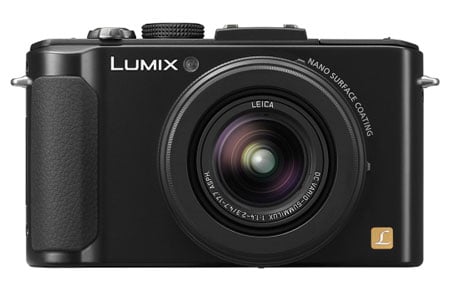 |
Panasonic Lumix LX7 Design and controls
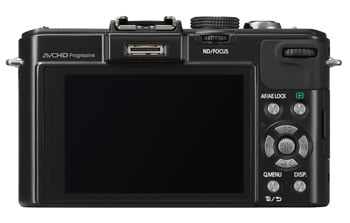 |
Measuring 111 x 67 x 46mm and weighing 298g with battery and card, the Lumix LX7 is virtually the same size and only a few grams heavier than its predecessor. It looks very similar, but there are a two new physical controls. The aspect ratio selector on the top of the lens barrel is joined by an aperture ring which allows direct selection of the aperture in modes that support it. And on the rear panel just behind the mode selector is a dual-function push-rocker switch which activates the 3EV Neutral density filter and is also used to adjust manual focus.
As before, the zoom rocker surrounds the shutter button, with two speeds allowing slower zooming during movie recording. The flash hotshoe is protected by a sliding cover which also stops dirt and dust from entering the accessory port just beneath it at the rear. This port and shoe also allow the LX7 to accommodate optional optical or electronic viewfinders.
In front of the hotshoe Panasonic has managed to squeeze in twin stereo microphones, the lack of which was a big let down on the LX5, particularly when not just the competition, but lesser models in Panasonic’s own line-up had them. There’s still no socket for connecting an external microphone, though, and no microphone option for the accessory port. On the right of the camera body you’ll find a door that lifts to expose the now more-or-less standard HDMI and USB / A/V out ports. A USB cable is supplied but you’ll need to buy a HDMI or A/V cable to connect the camera to your TV.
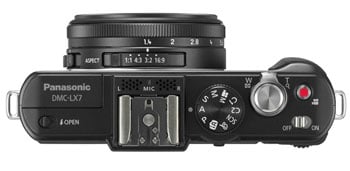 |
On the bottom of the LX7 the tripod bush is offset on the left side well away from the door to the combined battery/card compartment, which means you can change the card and battery with the camera mounted on a smaller tripod, or with a quick-release plate attached. The LX7 has 70MB of built-in memory, enough for about a dozen 10 Megapixel photos, and takes SD, SDXC and SDHC cards.
The Lumix LX7 takes the same 3.6V 1250mAh battery as its predecessor. Battery life is quoted at 330 shots which is a bit of a drop from the 400 shots the LX5 managed from the same power source. I’d assume the higher resolution screen is responsible for much of that and while it’s a little disappointing to see battery life shortening, 330 shots is still pretty respectable and in fact exactly what you’ll get with the Sony Cyber-shot RX100. Remaining battery life is indicated by a three segment icon.
The LX7’s built-in flash is manually popped up using a small lever located just behind it on the top panel. I’d be critical of this on a point-and-shoot compact, but on an enthusiast model like the LX7 it makes perfect sense. User’s will know when they want to use the flash and won’t want it popping up and firing unexpectedly in auto modes. When you’re finished with it you just push it back down into the camera body. This is the same system used on the PowerShot G1 X, but the Sony RX100 has a more conventional pop-up flash.
The flash has a quoted maximum range of 8.5 metres at the wide angle focal length with Auto ISO and has red-eye reduction and slow synchro modes. Alongside the popup flash is a fully-functional flash hotshoe onto which you can mount the optional DMW-FL220E, DMW-FL360E or DMW-FL500E flashguns for considerably longer reach than the built-in model. Obviously the bigger the flash, the more ungainly it will feel on the relatively compact body of the LX7, but the ability to accommodate external flashguns is a key advantage it has over smaller models like the Cyber-shot RX100 and PowerShot S110.
Panasonic Lumix LX7 Viewfinder and Screen
The Lumix LX7 has a 3 inch LCD screen updated to 920k pixels from its predecessor’s 460k. It retains the 3:2 aspect ratio which means when you’re shooting in the highest resolution 4:3 format there are narrow black bars down either side. However, the LX7’s sensor design and unique physical aspect ratio selector means you can shoot 3:2 images with a small drop in resolution to 9.5 Megapixels. So the 3:2 aspect ratio makes more sense than on many compacts with a 4:3 maximum resolution image size that you’re unlikely to change.
The LX7’s screen automatically adjusts to the ambient light and it also has the Power LCD mode seen on other Lumix models which brightens the screen for easier viewing in bright conditions. You can also adjust the brightness, saturation, contrast and colour balance of the screen, though obviously this has no impact on picture quality.
As well as increased resolution Panasonic says the screen also has a wide viewing angle and in practice the illumination drops off by very little when viewing it from an acute angle of more than 60 degrees or so. Compared with the slightly higher resolution screen on the Sony RX100, there’s actually not much of a difference in quality, though images on the RX100’s 3:2 screen fill the entire area at its highest 20 Megapixel resolution because its sensor is 3:2 proportioned. The RX100 screen is also very cool in White Balance by comparison with the LX7’s and while the Cyber-shot has brightness options, it lacks the colour control that the LX7 provides. Once again though, it’s worth reiterating that this only affects what you see on the screen and has no affect on the resulting images.
Looking at another rival, the 920k pixel screen on the PowerShot G1 X is 4:3 proportioned and also has the advantage of articulation, but at the cost of a much larger and heavier body. Also, with its optical viewfinder, you’re not restricted to the screen for framing shots. The same can be said for the LX7 if you’re prepared to pay a extra for either the DMW-VF1 optical viewfinder or the DMW-LVF2 electronic viewfinder. These accessories don’t come cheap though, and although they give the LX7 an advantage over the RX100 which doesn’t have a viewfinder or provide an optional accessory, at around half the price of the camera for the electronic LVF2, they add substantially to the cost of the overall package.
Panasonic Lumix LX7 lens and stabilisation
The Lumix LX7 is fitted with a new 4.7 – 17.7mm 3.7x zoom lens which has a 35mm equivalent range of 24-90mm. But the most interesting thing about the lens is not its zoom range, which is unchanged from its predecessor, but the brighter f1.4-2.3 maximum aperture. This makes it the brightest overall compact camera as the recently announced Samsung EX2F may share the same f1.4 focal ratio when zoomed-out but has a slower f2.7 ratio at 80mm. It’s an impressive specification and one which gives the LX7 a key advantage over other large sensor compacts.
Panasonic Lumix LX7 coverage wide |
Panasonic Lumix LX7 coverage tele | |
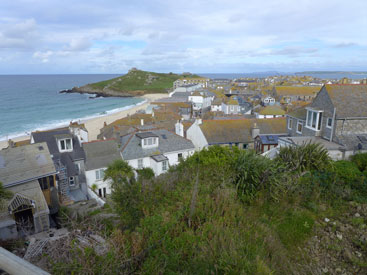 |  | |
| 4.7-17.7mm at 4.7mm (24mm equivalent) | 4.7-17.7mm at 17.7mm (90mm equivalent) |
Maximum aperture is a key specification for enthusiast cameras and the LX7 really has leapfrogged the competition in this respect. Its f1.4 wide angle setting is a 2/3EV wider than the Sony RX100, Olympus XZ-1 (and the newer XZ-2iHS), and Fujifilm X-F1 all at f1.8. It’s a full stop brighter than the Canon PowerShot S110 and there’s a two stop gulf between it and the PowerShot G1 X. And, impressively, the LX7 maintains or widens the gap when zoomed in with a maximum aperture of f2.3 at 90mm.
These figures aren’t only important for low-light shooting. When coupled with a sensor that’s larger than a typical point-and-shoot, the LX7 stands a better chance of achieving a shallow depth of field, something which small sensor compacts have never really been able to pull off. Shallow depth of field is desirable for shooting portraits and macro shots but several factors mitigate against it when shooting with compacts. Firstly the maximum aperture on zoom lenses tends to get smaller as you zoom in. Secondly, for macro shots the closest focussing distance may not be close enough to guarantee shallow depth of field which reduces the closer the subject is to the lens. Then there’s the size of the sensor itself and the corresponding focal length of the lens, as smaller sensors generally use shorter actual lenses, which in turn have a larger inherent depth-of-field. Conventional wisdom may suggest a camera with a larger sensor, like the Sony RX100 or Canon G1 X should allow a shallower depth of field than the LX7 even with the latter’s brighter aperture, but you may be surprised in practice. Let’s find out.
The Canon PowerShot G1 X may sport a large sensor, but suffers from a lens with a modest maximum aperture of f5.8 when zoomed in to 112mm and a closest focussing distance of 20 – 85cm depending on the zoom setting. The closest focussing distance of the Cyber-shot RX100 at 28mm equivalent is 5cm. But the Lumix LX7 beats them both, with a 1cm close focussing distance at 24mm in Macro Af mode.
Below are two comparisons of the macro capabilities and depth of field characteristics of the three models. For the first I set the lens to the widest angle position and maximum aperture and got as close as I could to the subject. Getting in close doesn’t just allow you to capture larger detail, the depth of field becomes much shallower. As you can see from the examples below, the Lumix LX7 allows you to get very close – the flower was almost touching the lens for this shot – with the result that the background foliage just a few inches behind the subject is nicely blurred. The Cyber-shot RX100 does a reasonable job, but at 5cm can’t quite match the LX7. Close ups aren’t really the PowerShot G1 X’s forté.
Panasonic Lumix LX7 |
Sony Cyber-shot RX100 |
Canon PowerShot G1 X | ||
 |  |  | ||
24-90mm at 24mm f1.4 |
28-100mm at 28mm f1.8 |
28-112mm at 28mm f2.8 |
For the shots below I zoomed in to the maximum focal length and shot the subject from the closest possible distance, again with the maximum avaliable aperture. All three cameras manage to blur the backround to a degree, but the closer focussing distance and the wider maximum aperture of the Lumix LX7 gets the best result.
Panasonic Lumix LX7 |
Sony Cyber-shot RX100 |
Canon PowerShot G1 X | ||
 |  |  | ||
24-90mm at 90mm f2.3 |
28-100mm at 100mm f4.9 |
28-112mm at 112mm f5.8 |
Okay, so how about portraits taken from a typical distance? Can any of the three take a lead in blurring the background? The following shots below were all taken at their maximum focal lengths and maximum apertures. As you can see, there’s actually not a lot in it. The two large sensor models are essentially neck-in-neck, while the LX7 is fractionally less defocused in the background. But I’d certainly say none takes a decisive lead, so if you were planning on buying a compact with a large sensor and fixed lens just to achieve a shallow depth of field, you should start rethinking. For typical portraits the three cameras here delivered a similar depth of field, but when it comes to macro the LX7 has the greatest potential thanks to the combination of a much closer focusing distance and a brighter aperture. I think these results may surprise many.
Panasonic Lumix LX7 |
Sony Cyber-shot RX100 |
Canon PowerShot G1 X | ||
 |  |  | ||
24-90mm at 90mm f2.3 |
28-100mm at 100mm f4.9 |
28-112mm at 112mm f5.8 |
The Lumix LX7 is equipped with Power O.I.S optical image stabilisation. It has two positions – on and off. To test it I zoomed the LX7 to its maximum telephoto focal length and shot a sequence of images at progessively slower shutter speeds, both with the stabilisation enabled and turned off. As you can see from the crops below the LX7 can produce sharp hand-held shots at speeds down to 1/5th – about four stops slower than convention dictates. Combined with its bright lens, which at the 90mm focal length is still brighter than comparable models at f2.3, the Lumix LX7 is a superb low light performer.
Panasonic Lumix LX7 Power O.I.S Off / On | ||||
 |  | |||
100% crop, 4.7-17.7mm at 17.7mm 80 ISO 1/5 O.I.S. off. | 100% crop, 4.7-17.7mm at 17.7mm 80 ISO 1/5 O.I.S. on. | |||
Panasonic Lumix LX7 shooting modes
As you’d expect from an enthusiast model, the Lumix LX7 offers full Manual, Aperture priority, Shutter priority and Program auto modes – indicated by the familiar PASM letters on the mode dial. In Manual Mode the aperture ring makes a big difference to the handling. Where on the LX5 you had to press the thumbwheel to toggle between aperture and shutter speed selection, you can now effectively do both at the same time with your left hand controlling the aperture ring and your right thumb on the thumbwheel.
In Aperture priority mode it works much the same way, except that without the shutter speed to worry about you can ready your finger on the shutter release to shoot as soon as the required aperture is selected. In Shutter priority mode the aperture ring is ignored and the shutter speed is set using the thumbwheel and, again, in Program Auto the aperture ring setting is irrelevant, with a push on the thumbwheel used to toggle between Program shift and exposure compensation.
All in all, the aperture ring is a very positive and worthwhile addition to the Lumix LX7. There’s just one little niggle, if you can call it that. When the lens is zoomed in you can twist the aperture ring all the way to it’s widest f1.4 position but, depending on the focal length, the actual aperture will be anywhere between f1.4 and f2.3. It’s a small point, you just have to be aware that it’s the readout on the screen and not the markings on the aperture ring you need to go by.
For an easier life, switching to Intelligent Auto mode takes care of pretty much everything delivering good results in pretty much any circumstances. The LX7 exploits Scene Detection, Intelligent ISO, Face Detection, Quick AF, Backlight Compensation, I.Resolution, Intelligent Zoom and stabilisation. Scene detection can choose from portrait, landscape, macro, night portrait, night landscape, sunset or baby presets, or fall-back on plain auto for general shots. Intelligent ISO detects subjects in motion and increases the sensitivity to allow a sufficiently fast shutter speed to eliminate blur.
Pressing the thumbwheel in intelligent Auto mode allows you to ‘defocus’ backgrounds using an on-screen slider – a first step to Aperture priority mode for beginners. If you want a little more control, but still want the LX7 to take the lead, the Menu offers a Intelligent Auto Plus option. Pressing the thumbwheel in this mode provides sliders for brightness (exposure compensation) and white balance (colouring).
Panasonic Lumix LX7 Intelligent Auto iHDR off |
Panasonic Lumix LX7 Intelligent Auto iHDR on | |
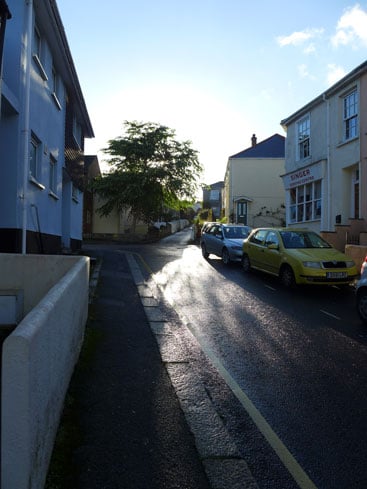 | 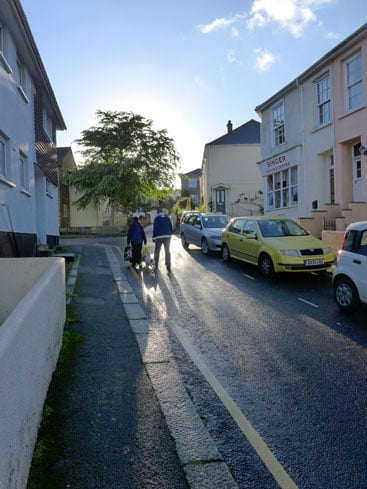 | |
| 4.7-17.7mm at 4.7mm ISO 80 1/800 f2.8 iHDR off. | 4.7-17.7mm at 17.7mm ISO 160 1/640 f4 iHDR on. |
Intelligent auto has some other advanced menu selectable options including Motion Deblur, iHandheld Nite Shot, and iHDR. Motion Deblur recognises subject movement and sets a higher shutter speed in order to freeze it. ihandheld Nite Shot is a stacking mode that takes a short burst of images and combines them for better results shooting hand-held in the dark. Finally, iHDR is another stacking mode that takes a short burst of images with different exposures and combines them to produce a result with a wider tonal range than would be possible in a single exposure. All three of these options are disabled by default but are well worth enabling, as you can see from the example above, they produce much better results, particularly at night and for high contrast subjects.
 |
 |
 |
| Expressive | Retro | Impressive Art |
 |
 |
 |
| High Dynamic | Cross Process | Toy Effect |
The Creative control position on the mode dial provides a wide range of filter effects – 16 in all including Expressive, Retro, Dynamic monochrome, Cross process, Toy effect, Miniature effect and Star filter. Some examples are shown above. Having selected the effect you want, further control over settings is provided by pressing the thumbwheel. For most, the adjustments are limited to exposure compensation (brightness), background defocus and saturation or colouring. It’s great to have this kind of control, but it would be even better if the additional options were more closely tailored to the specific effect. It would be nice, for example to be able to select the in-focus zone for the Miniature effect as you can on the PowerShot G1 X, adjust the colour of the Sepia effect, or adjust the vignette on the Toy effect.
You can apply the Creative control effects in the playback menu to JPEGs, so if the idea for a filter doesn’t occur to you until after you’ve taken the shot it’s never too late, and you can even apply multiple effects with each filter application saved to the card as a new JPEG. You can also use the Creative Control mode when shooting RAW +JPEG, giving you a JPEG version with the filter and an untouched RAW file to fall back on.
Panasonic Lumix LX7 movie modes
The LX7 now offers full HD video recording at 1920×1080 resolution at either 50 or 60 progressive frames per second, depending on region. It also gets an audio hardware upgrade from the mono mic of its predecessor to built-in stereo microphones mounted in front of the hotshoe. So it’s a much more capable video camera, though it still lacks the option to plug in an external mic – there’s no socket for one and Panasonic hasn’t announced any plans to produce one for the accessory port.
Video is encoded in AVCHD format in one of three quality settings. The best quality PSH mode encodes the 1080p/50/60 video stream at 28Mbps, FSH records 1080i50/60 at 17Mbps and SH records 720p50/60 also at 17Mbps. Switch to the alternate MP4 option and you have a further three choices; 1080p25/30 at 20Mbps (FHD), 720p25/30 at 10Mbps (HD) and 640×480 25fps at 4Mbps (VGA). There’s also a high speed video mode which shoots 720p25/30 at 100fps for 25fps playback at one quarter speed.
At 28Mbps the best quality video mode will fill up a 4GB card in around 20 minutes. The maximum continuous recording time is quoted at 90 minutes in PSH mode, assuming your battery lasts and the card capacity is sufficient, but on European models it’s limited to one second shy of 30 minutes. Panasonic recommends a card of speed class 4 or faster for video recording. You can use the zoom during video recording and the LX7 also provides a wind cut digital filter. You can record stills at a 16:9 aspect ratio and a 3.5 Megapixel resolution while video recording is taking place.
Press the dedicated record button with the mode dial in any position and the LX7 will start recording with exposure settings automatically determined. Switch to the Creative video position on the mode dial and you can record using any of the PASM modes. Exposure control is maintained during shooting, for example you can set Aperture priority mode and adjust the aperture during recording to bring the background into focus. You can also use manual focus, the rocker switch works surprisingly well for this, but the continuous AF is usually a better option. Pressing the shutter release half way during shooting causes the camera to refocus. The only obvious thing the LX7 lacks is the touch-focus feature offered by Lumix compacts and G series Micro Four Thirds models fitted with a touch sensitive screen.
| |
|---|---|
|
All of these clips were shot in the Lumix LX7’s best quality 1080p50 PSH movie mode. For this handheld panning shot Stabilisation was activated and does a good job of ironing out most of the wobbles. The 28Mbps encoded AVCHD video has a really nice quality and the AF does such a good job you don’t really notice it.
| |
|---|---|
|
Stabilisation was turned off for this tripod-mounted shot. Again the video quality looks very good. The LX7’s new MOS sensor has no problem with the directly into sun portion of the clip or the bright reflections on the water. In fact the exposure is excellent with plenty of detail in the sky. Once again the continuous AF does a great job.
| |
|---|---|
|
As you’d expect, this indoor low light panning shot has a little bit of visible noise, but the quality holds up well. The exposure is good and again the AF does an excellent job.
| |
|---|---|
|
For this final clip I zoomed in slighty to frame my coffee cup on the table before panning up to the bar and back again a couple of times to test the Lumix LX7’s continuous AF in low light conditions. The low light and bright reflections around the bar make this a difficult task for continuous AF to handle, but the LX7 takes it all in its stride. The coffee cup looks a little soft at times, probably because it’s right on the edge of the LX7’s close focus limit.
Panasonic Lumix LX7 handling
The Lumix LX7 starts up and is ready to take a shot in a fraction under two seconds from sliding the on/off button to the on position, providing you first remember to remove the lens cap. I’m beginning to sound like a broken record with the lens cap complaints but manufacturers will persist with this daftness. Leave the lens cap in place and the camera beeps at you and displays a message asking you to remove it and press any button, but at least the lens motor stops attempting to force itself past the obstruction in the meantime.
That’s the only real complaint I have with the LX7’s handling, in pretty much every other respect it’s a really nice camera to use. I’ve already mentioned how the aperture ring makes PASM mode shooting faster and more intuitive, I omitted to mention earlier that it has click stop positions at 1/3 EV increments which give it a nice positive feel. By contrast the Sony Cyber-shot RX100’s control ring has a smooth action with audible clicks at 1/3 EV increments, but you can’t feel a noise and it’s easy to miss in noisy environments. The big advantage with RX100’s control wheel though is that it’s programmable and can be assigned to other functions. Other than in Manual and Aperture priority modes the LX7’s aperture ring is redundant.
The Lumix LX7’s menu system is a little unwieldy. Pressing the menu button button presents you with three tabs for Rec (shooting) settings, Motion Picture settings and setup. The problem is there are six pages of settings on the first tab and eight on the last, which means interminable scrolling to find what you’re looking for with no way of knowing if you’re in the right place until you find it, or don’t. The system on the Canon PowerShot G1 X isn’t much better though, and neither is the Sony RX100, though its presentation is a bit of an improvement.
Thankfully, this doesn’t matter hugely because most of the important settings are on the Q Menu which includes Photo Style, Flash, Motion picture settings, Resolution, Image quality, AF area, Metering mode and Exposure compensation. Sadly, the redesigned Q.menu is a step backward in design terms. It all works fine until you get to the final two options, which can’t be accommodated on the screen without scrolling, so you don’t even know they exist until you scroll beyond the AF area option. Then, for reasons best know to themselves, Panasonic decided to change the layout of the controls, moving everything from the top of the screen to the bottom. It’s fine once you get used to it, but it isn’t what you’d call good UI design.
Panasonic could sort out the Q.menu problems by making it customisable. As things stand, the Lumix LX7 offers a reasonable degree of of customisation for an advanced compact. The left button on the four-way controller is labelled Fn and can assigned one of 14 functions including Quality, Metering mode, AF mode, Focus area selection, Guide line and the newly introduced electronic level guage. Those last two are of course display overlays which you’d normally access with the dedicated display button.
Two positions on the mode dial which I didn’t mention earlier when discussing exposure modes are labelled C1 and C1 and between them provide access to four memorised custom setups – one on the C1 position and three on C2.
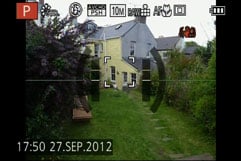 |
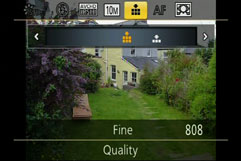 |
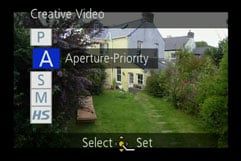 |
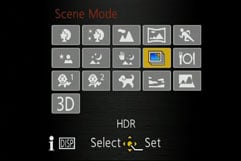 |
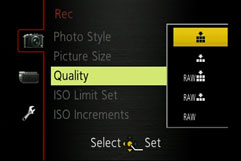 |
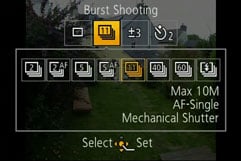 |
Panasonic Lumix LX7 Focussing
The Lumix LX7 offers broad control over focusing. First of all there’s the switch on the side of the lens barrel which lets you choose from AF, Macro AF and Manual AF. The latter is operated using the ND/Focus lever and, with MF Assist activated, provides a 4x, 5x or 10x magnified view which can be toggled by pushing the lever in. There’s also a distance scale for broad verification of the focus distance. Most manual focus systems of this kind are a bit of a palaver, but manual focussing on the Lumix LX7 is surprisingly efficient and effective.
As for the AF modes, the Lumix LX7 offers four main options which can be manually selected in the PASM modes, or left to the camera to choose from in auto. First is Face Detection, which can detect and track human faces. This works alongside Face Recognition, which can memorise up to six people (using one to three poses) along with their names and birthdays if desired. Once registered, these faces can have focusing priority over ‘strangers’, and it’s also fun to see their name popup under the tracking frame. If the subject’s age is less than three years old, the camera will also automatically switch to its Baby scene preset in auto modes.
The second AF mode is AF Tracking, which is like face detection for non-human subjects. This allows you to place a target over a subject, after which the LX7 will track it across the frame and adjust its focus as required. Next up comes the standard 23-area AF system, which the LX7 defaults to in the absence of recognisable faces in the auto modes. The fourth AF mode is single-area, which as its name suggests, just uses one area, the position and size of which can be adjusted.
In practice, the Lumix LX7’s AF is fast and sure-footed. Other than a name change from the LX5’s Sonic Speed AF to Light Speed AF on the LX7 Panasonic isn’t claiming any specific AF performance enhancements. What I can tell you is that in general use in all kinds of lighting situations the LX7 consistently outperformed the Canon Powershot G1 X and the Sony Cyber-shot RX100 both in terms of its speed and reliability.
Panasonic Lumix LX7 Continuous shooting
The Lumix LX7 can shoot a continuous burst of 12 full resolution JPEG images at 11 frames per second. This is a massive improvement on the 5 standard or 3 Fine JPEGs its predecessor could shoot at a meagre 2.5fps. At the 11fps setting focus, exposure, and white balance are fixed on the first frame, but the LX7 also has 5fps and 2fps continuous AF burst modes with a 100 frame capacity. In these modes focus, exposure and white balance are adjusted for each shot. Finally, the LX7 retains the 40 and 60fps reduced resolution burst modes of the Lumix LX5
To test the Lumix LX7’s continuous shooting I fitted it with a freshly formatted Sandisk Extreme Pro UHS-1 card. In shutter priority mode with with 1/500 selected, I fired off a burst of 12 frames in exactly one second – a little faster than the quoted speed and a very impressive performance indeed. It takes five and a half seconds to write the 12-frame burst to the card, but you don’t have to wait for it to finish before you can start shooting again and can shoot shorter bursts more or less immediately, though, obviously, the longer you wait the more shots you’ll get. Switching to a speed class 10 SDHC card made no difference to these timings, so, while you can use the faster UHS-1 cards in the LX7, there’s no performance premium to be gained.
The Lumix LX7 provides three-shot auto bracketing up to a maximum 3EV in 1/3EV increments. The Drive mode menu also includes three self-timer options at 2 seconds, 10 seconds and 10 seconds with three frames shot about 2 seconds apart. Not a bad range of options, but not as versatile as the RX100’s self-portrait, or Smart Shutter on the PowerShot G1 X.
Panasonic Lumix LX7 Sensor
The Lumix LX7 has a newly designed 10.1 (effective) Megapixel MOS sensor which replaces the CCD sensor of the same resolution in the Lumix LX5. The 1/1.7in sensor measures 7.4 x 5.6mm and is larger than the 1 / 2.3in sensors found in most compacts, but remains significantly smaller than the Cyber-shot RX100’s 1in sensor (13.2 x 8.8mm) and the PowerShot G1 X’s (18.7 x 14mm).
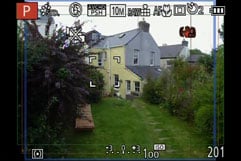 |
The LX7’s sensor actually has a total Megapixel count of 12.8. As with earlier models in the range the pixels around the edges of the frame are used to maintain the angle of view and avoid cropping at different aspect ratios. So with the camera zoomed-out, you’ll enjoy 24mm coverage whether you’re shooting in 4:3, 3:2 or 16:9 aspect ratios. Shoot the same scene with each aspect ratio and you’ll see the wider modes may capture less vertically, but more horizontally.
That said, the LX7’s maximum pixel-count comes when shooting in 4:3 mode, where the 10.1 effective Megapixels deliver images with 3648×2736 pixels. Switch to 3:2, 16:9 or 1:1 aspect ratios and the resolution falls to 9.5, 9 or 7.5 Megapixels respectively. Each aspect ratio is also available at four lower resolutions, and in the choice of two JPEG compression levels. As a high-end model, the LX7 can also record its files in the RAW format, either by themselves or accompanied by a JPEG at either of the two compression levels.
Set to 10M Fine mode, images typically measure around 4MB each, and Panasonic has increased the built-in memory to around 70MB, so you can shoot a handful of images without a card. The sensitivity ranges from 80 to 6400 ISO at full resolution, with a 12800 ISO option at a greatly reduced resolution. The shutter speed range is 250 seconds to 1/4000.
To see how the quality of the Panasonic Lumix LX7 measures-up in practice, take a look at my Panasonic LX7 quality and Panasonic LX7 noise results pages, browse my Panasonic LX7 sample images, or skip to the chase and head straight for my verdict.
 It's not perfect of course: the aperture ring becomes redundant in some modes when it could have been customisable, the fixed lens cap still obstructs the camera on power-up, there's no Wifi, GPS or touch-screen, and there are some situations where a bigger sensor will prove preferable. But the positives far outweigh the negatives: the LX7 is a truly impressive advanced compact and one I have no hesitation in highly recommending. Panasonic has proven in a market filling with compacts boasting large sensors, that there's still reasons why you may prefer one with a smaller sensor - so long as it's also coupled with a nice bright zoom.
It's not perfect of course: the aperture ring becomes redundant in some modes when it could have been customisable, the fixed lens cap still obstructs the camera on power-up, there's no Wifi, GPS or touch-screen, and there are some situations where a bigger sensor will prove preferable. But the positives far outweigh the negatives: the LX7 is a truly impressive advanced compact and one I have no hesitation in highly recommending. Panasonic has proven in a market filling with compacts boasting large sensors, that there's still reasons why you may prefer one with a smaller sensor - so long as it's also coupled with a nice bright zoom.



